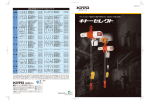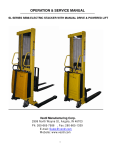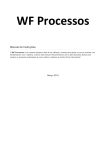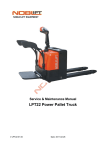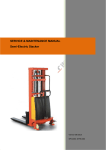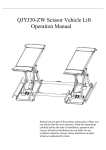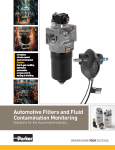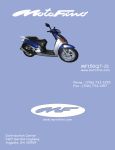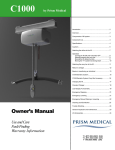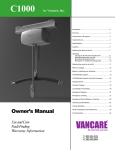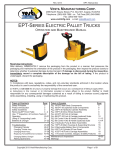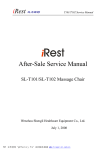Download S-Series Powered Drive & Powered Lift Owner`s manual
Transcript
OPERATION & SERVICE MANUAL S SERIES STACKER WITH POWERED DRIVE & POWER LIFT Vestil Manufacturing Corp. 2999 North Wayne St., Angola, IN 46703 . Fax: 260-665-1339 Ph: 260-665-7586 E-mail: [email protected] Website: www.vestil.com 1 General Read and follow the instructions contained in this operating manual without fail! Only trained, well-informed personnel, who have been instructed in accordance with this operation manual, may use or work on the machine. Liability or guarantee is waived if: The instructions in this operating manual are not observed. The high-lift stacking truck is operated, cleaned or maintained incorrectly. Alterations to the functions are carried out without the consent of manufacturer. Original spare parts are not used. Safety instructions This chapter informs the user about residual dangers relating to the correct use of the products. It contains generally valid safety instructions which must be observed. Safety instructions relating to specific actions or situations are listed prior to the respective action and/or description of the situation in the chapter. Principles This product complies with state-of-the –art technical standards and recognized safety regulations, but there are still dangers which may occur which must be considered. Only operate the product in a perfect condition and observing the information contained in the operating manual. The operator is responsible for integrating the product with as little risk as possible into his working environment. This obligation continues through every phase of the products lifespan, beginning at the planning stage. Residual dangers are to be minimized. Only trained, competent personnel who have been instructed using the operating manual and the product are permitted to work with the truck. The operating manual must be understood (responsibility, checking) Declaration: I have read this manual and, in particular, have taken note of the caution. Name Date Signature 2 Specification SPECIFICATION Capacity S-62-FF S-62-AA S-62-FA 2000 lbs. 2000 lbs. 2000 lbs. Fork Lift Height 62" 62" 62" Fork Dimension 42x5.9x2 3/8" 42x4x1-1/4"" 42x5.9x2 3/8" 26-3/4" 26-3/4" 26-3/4" 1" 1" 1" 2-9/16" Overall fork width Ground Clearance Lowered Fork H. 3-3/8" 2-1/8" H. Overall Extended 81-7/8" 81-7/8" 81-7/8" 26-1/2x30x29-3/4" 26-1/2x30x29-3/4" 26-1/2x30x29-3/4" Head Dimension Loading Center 23-5/8" 23-5/8" 23-5/8" Wheel Base 44-3/4" 44-3/4" 44-3/4" Turning Radius 55" 55" 55" Support Wheel Φ4x2" Φ4x2" Φ4x2" Front Wheel Φ3-1/8x3-3/8" Φ3-1/8x3-3/8" Φ3-1/8x3-3/8" Drive Wheel Φ10x3-1/8" Φ10x3-1/8" Φ10x3-1/8" Overall Size 68x30x82 69x46x82 68x46x82 Lift Load 2.95"/s 2.95"/s 2.95"/s Speed Unload 5.9"/s 5.9"/s 5.9"/s Lower Speed Load 4"/s 4"/s 4"/s Unload 2"/s 2"/s 2"/s Travel Speed Load 5km/h 5km/h 5km/h 6km/h 6km/h 6km/h Drive Motor Unload 24V/700W 24V/700W 24V/700W Lift Motor 24V/2.0KW 24V/2.0KW 24V/2.0KW Controller 1207A-4102 1207A-4102 1207A-4102 Battery 2x12V/70Ah 2x12V/70Ah 2x12V/70Ah DC 24V/6A Soneil DC 24V/6A Soneil DC 24V/6A Soneil 950 lbs. 990 lbs. 970 lbs. 6% 6% 6% 10% 10% 10% 35-1/2" 52" 52" Battery Charger Weight Load Grade ability Unload Grade ability Width of Aisle Note: The load capacity is based on the situation when the center of the gravity is located at the center of length of forks. When the center of gravity of goods is out of the center of forks, the load capacity will be lessened compared to the center. 3 CO N T E N T S General ………………………………………………………………………………… 2 Specification …………………………………………………… 3 Receiving instructions ……………………………………………………………… 5 Safety Notes ……….…………………………………………………………………… 6 Product description ………………………………………………………………… Designated use …. … …... … …………………………………………………… Signs on the Truck ……………………………………………………………….. 7 7 8 Transport ………………………………………………………………………………… 9 Operation ……………………………………………………………………………… 10 Operation ……………………………………………………………………………… Operating elements ……………………………………………………………… Safety elements ………………………………………………………………… Driving, braking and horn………………………………………………………… Lifting and lowering ………… …………………………………………………… Traveling ………………………………………………………………………….. Taking up the load………………………………………………………………… Driving on sloping surfaces……………………………………………………… Maintenance and repair …………………………………………………………… Trouble shooting ………………………………………………………………… Changing batteries ……………………………………………………………… Changing motor controller …………………………………………………….. Belly switch trouble shoot ……………………………………………………… Maintenance daily/before use, monthly, annually …………….…………….. Maintenance and care of the load chains …………………………………… Chain inspections ………………………………………………………………… Temporary lay-up ………………………………………………………………… 11 12 13 14 15 16 17 18 18-22 23-24 25-31 32-49 50 51 52 53 Parts List ………………………………………………………………………………… 54-60 4 Receiving Instructions Every unit is thoroughly tested and inspected prior to shipment. However, it is possible that the unit may incur damage during transit. If you see damage when unloading, make a note of it on the SHIPPER RECEIVER. Remove all packing & strapping material, inspect for damage. IF DAMGE IS EVIDENT, FILE A CLAIM WITH THE CARRIERIMMEDIATELY! Also, check fork size, type of power unit, etc., to see that the unit is correct for the intended application. Warnings & Safety Instructions Insure that all employees understand and follow the following instructions • Read and understand the owner’s manual before using or servicing the stacker. • Do not use the stacker if any damage or unusual noise is observed. • Improper use of this lift truck could result in injury and damage to load or equipment. • Always watch the stacker and any load on it carefully when it is being used or moved. • Avoid sudden stops or quick turns to turns to prevent accidental tipping of the load. • Load must be centered and evenly distributed on the forks. • Park the truck on level surfaces and not in the way of other products • When parked, lower the load fork completely. • When parked, push E-switch push-button down. • Do not perform any modifications to the stacker without the manufacturer’s approval. Failure to receive authorization for changes to the equipment could void the warranty. • Do not use brake fluid or jack oil in the hydraulic system. If oil is needed, use an anti-wear hydraulic oil with a viscosity grade of 150 SUS at 100°F, (ISO 32 @ 40°C), or a non-synthetic transmission fluid. • Use only replacement parts either supplied or approved by the manufacturer. 5 Safety notes Symbols and pictograms used In addition to the text and illustrations, this operating manual contains various symbols which should draw attention to the safety requirements. They generally have the following appearance: Signal wording DANGER WARNING CAUTION Explanation Warning of an imminent danger! Non-observance cause death or serious injury Warning of a possibly incoming dangerous situation. Non-observance may cause death or serious injury. Warning of a possibly incoming dangerous situation. May also be used for warnings of major damage to property. Other definitions: DIRECTION IMPORTANT Marks recommendations for use and other useful information. Does not warn of dangerous situations. Warns of a harmful situation. Non-observance may cause damage to material. Used symbols and pictograms Possible danger to file and limb or machine! Do not step onto when load is raised! Danger of crushing! It is forbidden to ride on the truck! Do not reach into running motor! Suspension points for transport of truck! Wear safety shoes Important Wear helmet Suspended warning! 6 load Product description Designated use The stacker is designated for lifting, lowering and transportation of loads according to the specifications of the identification plate. The stacker is to be used on hard level surfaces. To move the stacker between buildings, warehouses etc The gradient of the slope must not be more than 10% Make sure load is not loose or unstable. Do not pick up loads on tips or forks or edge of platform. Do not overload. The road surfacing must be solid and have a good grip. Travel routes must offer sufficient load-bearing capacity for the loaded truck. The stacker is not suitable for continuous use in cool-houses! Ambient conditions Temperature From To Degree of humidity Permitted floor incline Loaded Unloaded ¹ Dimensions and weights Mass (dead weight) m 14 113 ≤70 °F °F % Max. 0.5 Max. 2.0 % % 480/750 kg WARNING! The user is responsible for determining the actual load bearing capacity of a high-lift stacking truck. This can depend on the user, the condition of both the floor and the high-lift stacking truck and the regularity of the maintenance intervals. 7 Product description 8 Removing from the pallet or lifting the product Lifting belt specification— Use polyester lifting sling or nylon sling and hoist with a minimum of 2,000 lb. capacity. CAREFUL To pick up the unit only use overhead hoist, forklift or loading crane with sufficient carrying capacity! Refer to the identification plate for the weight of the truck. DANGER When unloading the truck, all personnel should be cleared from area. 9 OPERATION Visually inspect stacker for damaged and worn parts, before stacker is taken into operation. Authorized person should read and understand all instructions The lifting truck is ready for immediate use once the packaging has been removed. The battery is full and charged. The hydraulic tank is full. The driving gear is filled with oil filling for approx. 200 operation hours. The steering roller and the running rollers are equipped with bearings which do not require maintenance; all mast rollers are also free from maintenance. Caution! Pedestrian controlled industrial trucks may only be operated by persons who have been satisfactorily instructed in operating the truck and have proved their ability to operate the truck to the responsible representative of the operating company. The first driving attempts should take place on level and spacious surfaces. Recommendation: The operator who is to maneuver the truck and is to control the lifting mechanism should be allowed to practice, when unloaded, until they can safely operate these functions. Only then should they undertake the loading, transporting and unloading of load. 10 Operation 11 Operation 12 Operation Driving Pull up the red push button of the E-switch Tilt the Control handle to driving position, the locking brake is released If you release Control handle, this returns to the vertical start position, the truck brakes and the locking brake activates The truck is steered via the Control handle Brake: This stacker is equipped with a magnetic brake that is applied between 10-15 degrees of the vertical position and between 85 -90 degrees of the lower position in the vertical operating of the handle. The brake can be operated at any point in the lateral operating of the handle. When you release your hand from the handle, it will resume neutral position automatically, and will activate the brake. Always make sure that the brake is in work before operating the stacker. When parked, always put the handle in the full vertical position with the brake applied and forks lowered. Horn: A horn is located on top of the handle. 13 To raise and lower The following are generally valid for the lifting and lowering procedure: The red operating button of the EMERGENCY STOP pushbutton must be pulled upwards Lifting and lowering movements are initiated by pressing the pushbuttons on the handle head. There are four buttons located on the two sides of the handle. Each side of the control has one button for raising the forks and one button for lowering the forks. Always make sure when lifting that the load is within the capacity rating of your truck and that the load has been stacked safely on the pallet. Also, make sure that there is no one standing near the forks when raising or lowering. It is also important to make sure that the length of the forks corresponds to the opening in the bottom of the pallet. The load rollers must be placed between boards so when you raise the forks, the pallet will not be broken or damaged. Always make sure when entering the pallet that the forks are in the fully lowered position. Be careful when lifting pallets that are too short or too long for the truck Warning It is forbidden to climb or reach into any moving parts of the lifting truck-e.g. the lifting frame, thrust units, lifting mechanisms etc. 14 Travel The butterfly switch controls the direction and speed of the lift truck. Rotating the butterfly control towards the forks moves the truck in the forward direction. Rotating the butterfly control away from the forks, moves the truck in the reverse direction. The control is progressive – the further you rotate the control, the faster the truck will travel. DIRECTIONAL SPEED CONTROL THROTTLE Emergency reverse safety button At the top of the handle is a red safety reverse button. The button is designed to change the travel direction away from the operator when depressed. The truck will stop moving away from the operator when the button is released. When the fork truck is traveling forward (away from the operator) the button has no effect when activated. If the belly switch becomes jammed or stuck, it will move forward (away from the operator) for a maximum of 3 seconds at which time the control circuit will become disabled until the handle is re-set to the full up or full down position and the belly switch is returned to normal operation. BELLY SWITCH (SAFETY REVERSE BUTTON) 15 Operation Lifting load CAUTION! Before lifting a load to be transported, ensure that the load does not exceed the carrying capacity of the truck. The nominal carrying capacity and lifting heights can be viewed in the load diagram. Ensure that the load can be taken up in a compact and stable manner. Slipping or falling of the load must be avoided. The load must not project into the lifting frame. The load must be centered and evenly distributed on the forks. The load must not project more than 50mm over the end of the lifting forks. Transporting the load CAUTION! Raise the load only slightly to transport For safety reasons (view) transport only in a forward direction Only when lifting up or lowering down the load it is permissible to drive forwards or in reverse with a raised load Lift up or lower down loads on level surfaces When unloaded, move stacker only with forks lowered 16 Operation Driving on sloping surfaces 17 Maintenance and repair TROUBLESHOOTING GUIDE -- ______ Warning: Before performing any task, always block drive wheel off of the ground. Consult the factory for problems at time of installation, or for any problems not addressed below. Problem: Unit doesn’t move when controls are used. Unit will not charge Unit will not go forward; reverse works; belly switch just kills unit (does not go forward and time out) Possible cause(s): Battery voltage low (<17) Charge batteries. Problem with motor controller (check for LED flash code on side of controller) Consult diagnostics page/factory Fuse blown Remove back shroud and check fuses (3 fuses). Charger malfunction Verify output voltage on charger, will only get a reading when connected to batteries; should be approximately 28 volts. Bad batteries Load test batteries Broken wire, or loose connection Locate Pin 2 on Molex connector at motor controller. Trace wiring to contactor and verify connection. Contactor bad, motor controller bad Unit will not go reverse; belly switch works (i.e. when the handle is in operating range and rotating throttle in reverse and the belly switch is hit, the unit moves forward and times out) Action: Broken wire, or loose connection, contactor bad, motor controller bad 18 When forward is depressed, there should be 24 volts on this wire from Molex connector to the contactor, if not, the motor controller may be bad; consult diagnostics page/factory. If 24 volts is present at contactor, verify ground connection. If ground is good, remove both wires and check with ohm meter; resistance should be approximately 38 ohms. If it’s open or zero, the contactor should be replaced. Same as above; except locate Pin 3 on Molex connector on motor controller…and follow procedure. Problem: Unit will not go forward, or reverse, but belly switch still functions properly. Possible cause(s): Broken wire, or loose connection, bad motor controller, Throttle assembly bad Unit will not move forward, or reverse, and the Belly switch will not function, unit does turn on as indicated by the battery gage lighting up. Action: Locate Pin 6 on Molex connector at the motor controller. Try to drive the unit in forward, there should be 0 to 5 volts (5 v is full throttle) at this pin. If there is voltage and the unit does not move, the motor controller may be bad, consult diagnostics page/factory. If there is no voltage, trace the wiring back towards the tiller head and check voltage on each side of connectors. Continue this until bad connection is found. If the connections are all good, and there is no voltage coming out of throttle assembly, then the throttle assembly may be bad. Verify there is 24 volts going into the assembly and that there is a good ground. If there is still no output voltage for pin 6, replace throttle assembly. See Fig. 1 Blown fuse Verify fuses are good, replace if blown. Broken wire, or loose connection Locate Pin 7 on Molex connector at the motor controller. Trace wire back up to tiller head and verify continuity all the way to the throttle assembly. Repair any loose connections. If there is continuity up to the throttle assembly, then check the ground wire that comes off of Bon the motor controller (3rd terminal down). Add more length to this wire if necessary, and re-terminate with a ring terminal. Unit will not go forward; the belly switch functions; reverse works. Broken wire, or loose connection, bad motor controller Locate Pin 11 on Molex connector at the motor controller. Try to drive the unit in forward; there should be 24 volts at this pin. If there is voltage and the unit does not move, the motor controller may be bad, consult diagnostics page/factory. If there is no voltage, trace the wiring back towards the tiller head and check voltage on each side of connectors. Continue this until bad connection is found. Bad throttle assembly If the connections are all good, and there is no voltage coming out of throttle assembly, then the throttle assembly may be bad. Verify there is 24 volts going into the assembly and that there is a good ground. If there is still no output voltage for pin 11, replace throttle assembly. See Fig. 1 19 Problem: Unit will not reverse; belly switch does not function; forward ok Possible cause(s): Broken wire, or loose connection, bad motor controller Bad throttle assembly Belly switch does not function; forward ok; reverse ok Broken wire, or loose connection, bad motor controller Bad belly switch Unit will not reverse. The unit only goes forward for about 1 second and dies when the handle is pulled down. When the handle is re-set and pulled down the unit will move forward again then die. Stuck Switch 20 Action: Locate Pin 12 on Molex connector at the motor controller. Try to drive the unit in reverse; there should be 24 volts at this pin. If there is voltage and the unit does not move, the motor controller may be bad, consult diagnostics page/factory. If there is no voltage, trace the wiring back towards the tiller head and check voltage on each side of connectors. Continue this until bad connection is found. If the connections are all good, and there is no voltage coming out of throttle assembly, then the throttle assembly may be bad. Verify there is 24 volts going into the assembly and that there is a good ground. If there is still no output voltage for pin 12, replace throttle assembly. See Fig. 1 Locate Pin 13 on Molex connector at the motor controller. Try to drive the unit in reverse, and hit the belly switch… there should be 24 volts at this pin. If there is voltage and the unit does not move, the motor controller may be bad, consult diagnostics page/factory. If there is no voltage, trace the wiring back towards the tiller head and check voltage, or continuity on each side of connectors. Continue this until bad connection is found. If the connections are all good, and there is no voltage, then the switch may be bad. Verify there is 24 volts going into the switch. If there is still no output voltage for pin 13, replace the switch. The belly switch is stuck on. Tap the orange assembly to see if the switch can be freed. If this doesn’t work, disassemble the tiller head by removing 3 screws from bottom. Slightly loosen up the two screws that hold the switch in place, this may free the switch. If it is still stuck, contact the factory for a replacement switch. Problem: Unit will not raise; motor does not run Possible cause(s): Loose wire Bad solenoid Upper limit switch out of adjustment Blown fuse Batteries discharged Action: Verify 24 volts at coil when raise is pushed, if no voltage; trace wiring back to till her head looking for voltage on each side of the connectors until the bad connection is found. If voltage is present at the solenoid and the unit does not rise, remove the two wires to the coil and measure the coil resistance. It should be around 19 ohms. If it’s open, or shorted replace the solenoid. Bypass upper limit switch and see if the unit raises…DO NOT TAKE IT ALL THE WAY UP… If it does rise, verify the limit switch is normally closed and will open when activated. If the limit switch is ok, try to adjust the switch accordingly so that the units raise height is approximately 7 to 8” Check fuses above motor controller Unit will not raise; motor runs Lower solenoid stuck on Unit will not lower No hydraulic oil Loose wire; bad coil Re-charge batteries Check to see if the lowering switch is stuck on. If it is, remove the tiller head via 3 screws on bottom and replace switch, or tap on switch to see if it can be freed up. Re-fill hydraulic oil Verify 24 volts at coil when lower is pushed, if no voltage, trace wiring back to tiller head looking for voltage on each side of the connectors until the bad connection is found. If voltage is present at the coil and the unit does not lower, remove the connector to the coil and measure the coil resistance. It should be around 39 ohms. If it’s open, or shorted replace the coil. Upper limit switch out of adjustment Loosen hydraulic line at pump to relieve pressure build up. Re-adjust limit switch so unit stops at 7 to 8 inches above the ground. Look for binding in chain or rollers Unit keeps blowing fuses when the raise button is pressed Shorted solenoid for motor raise 21 Remove the wire to the solenoid coil on the pump motor. Measure the resistance; it should be around 19 ohms. If it is nearly zero ohms replace the solenoid. Problem: Possible cause(s): Action: Unit will not reverse; belly switch does not function; forward ok Broken wire, or loose connection, bad throttle assembly, bad motor controller. Locate Pin 12 on Molex connector at the motor controller. Try to drive the unit in reverse; there should be 24 volts at this pin. If there is voltage and the unit does not move, the motor controller may be bad, consult factory. If there is no voltage, trace the wiring back towards the tiller head and check voltage on each side of connectors. Continue this until bad connection is found. If the connections are all good, and there is no voltage coming out of throttle assembly, then the throttle assembly may be bad. Verify there is 24 volts going into the assembly and that there is a good ground. If there is still no output voltage for pin 12, replace throttle assembly. Lifting height is not longer achieved Hydraulic oil level is too low Re-fill hydraulic oil when forks are lowered. Unit jerks when lifting Air in the system Open vent screw on the lift cylinder with forks lowered all the way down. Lift forks with vent screw open until oil is free from air bubbles. Close the vent screw Forks raise, then drift down Check valve or Solenoid valve leaking (contamination holding open the lowering valve or the check valve) Remove & inspect. . Remove any load from the forks. . Remove the nut holding solenoid coil on the valve stem, and then unscrew the valve from the manifold. . Inspect the valve for contaminants, and the valve’s o-rings and back –up washers for cuts, tears, and other damage. . With valve immersed in mineral spirits or kerosene, use a thin tool such as a small screwdriver or a small hex wrench to push the poppet in and out several times from the bottom end of the valve. The valve should move freely, about 1/16” from closed to open position. If it sticks in, the valve stem could be bent and will need to be replaced if it doesn’t free up after cleaning. Blow the valve off with a compressed-air gun while again pushing the poppet in and out. 22 Filename: Changing Batteries in S-62 Stacker VESTIL MFG. CO. Model: S-62/AA/FF/FA Instructions for Changing the Batteries, estimated time, 15 min. READ ALL INSTRUCTIONS BEFORE PROCEEDING! Only qualified personnel should work on this equipment! Lock out all potential energy sources before attempting this installation; turn off the unit and remove the key. Warning! ! Working with or near lead acid batteries is dangerous. Batteries contain sulfuric acid and produce explosive gases. A battery explosion could result in loss of eyesight or serious burns. ! Do not smoke or allow a spark or flame near batteries. Charge batteries in locations which are clean, dry, and well-ventilated. Do not lay tools or anything metallic on top of any battery. All repairs to a battery must be made by experienced and qualified personnel. ! When working with batteries, remove personal items such as rings, bracelets, necklaces, and watches. Batteries can produce enough energy to weld jewelry to metal, causing a severe burn. ! Always have fresh water and soap nearby in case battery acid contacts skin, clothing, or eyes. ! Operating the battery with a low battery voltage can cause premature motor contact failure. ! Do not expose the lift or charger to rain or adverse conditions. ! Replace defective cords or wires immediately. ! Check the battery’s water level frequently if this applies to your battery type. ! Make sure the battery charger is unplugged from 115vac source. Battery Charger Operating Instructions Plug the charger into a standard 115V receptacle. If an extension cord must be used, keep it as short and as large as possible. A small cord will decrease the output of the charger due to the voltage drop in the line. This will increase the charging time. It can also cause the 115V cord to overheat. When properly connected, the charge LED will indicate the status of charge current flowing to the battery, as follows: Power LED is always green when charger is plugged in. The status light is as follows: Red only – the charger is providing full output to the battery. Yellow – the charger is “topping off” the battery. Green – the charger is providing a “float,” or maintenance, charge. Remember to unplug the charger before moving the equipment. and other equipment. 23 Failure to do so could cause damage to cords, receptacles Troubleshooting: If the unit does not operate, check all of the wiring connections to make sure they’re both mechanically and electrically sound – specifically at the battery, and the motor. A fully-charged lead acid battery in good condition at room temperature should read 12.65 volts. At 11.9 volts it is considered to be fully discharged and in need of charging. When checking battery voltage, wait at least 1\2 hour after the charger has been turned off before checking the battery’s voltage. If the batteries aren’t being charged by the charger, check the output charger fuse. Verify fuse is good with an ohmmeter, or close visual (ohm meter best). Fuse is a 10Amp 250 Volt; GBD 10A. If it is good, check the battery’s state of charge with a voltmeter. The charger must be connected to the battery in order to read the output voltage of the battery charger. Depending on the state of charge of the batteries, the voltage should be somewhere around 27 to 28 volts dc. If it is determined the batteries are dead, and need replaced, change the batteries. Tools Required: 14mm wrench, or crescent wrench Regular flat bladed screw driver 24 Filename: Changing Motor Controller in S-62 Stacker VESTIL MFG. CO. ModelS-62-AA/FF/FA Instructions; Changing the Motor Controller in; estimated time, 30 min. READ ALL INSTRUCTIONS BEFORE PROCEEDING! Only qualified personnel should work on this equipment! Lock out all potential energy sources before attempting this installation; turn off the unit and remove the key. Warning! ! Working with or near lead acid batteries is dangerous. Batteries contain sulfuric acid and produce explosive gases. A battery explosion could result in loss of eyesight or serious burns. ! Do not smoke or allow a spark or flame near batteries. Charge batteries in locations which are clean, dry, and well-ventilated. Do not lay tools or anything metallic on top of any battery. All repairs to a battery must be made by experienced and qualified personnel. ! When working with batteries, remove personal items such as rings, bracelets, necklaces, and watches. Batteries can produce enough energy to weld jewelry to metal, causing a severe burn. ! Always have fresh water and soap nearby in case battery acid contacts skin, clothing, or eyes. ! Operating the battery with a low battery voltage can cause premature motor contact failure. ! Do not expose the lift or charger to rain or adverse conditions. ! Replace defective cords or wires immediately. ! Check the battery’s water level frequently if this applies to your battery type. ! Make sure the battery charger is unplugged from 115vac source. Troubleshooting: If it has been determined the motor controller needs to be replaced, the following procedure can be used. Tools Required: 2x 14mm wrench, open face Philips head screwdriver 8mm wrench 25 Filename: Changing Motor Controller in S-62 Stacker VESTIL MFG. CO. ModelS-62-AA/FF/FA Verify power if off to the unit; key switch off! Remove yellow cover; two screws on top. The Campro motor controller is shown here. 26 Filename: Changing Motor Controller in S-62 Stacker VESTIL MFG. CO. ModelS-62-AA/FF/FA The wiring must be marked The wiring should be marked in a unique way to remember where it all goes when re-connecting. One possible method is shown below. Remove the two 14mm bolts holding the motor controller mounting plate to the frame. 27 Filename: Changing Motor Controller in S-62 Stacker VESTIL MFG. CO. ModelS-62-AA/FF/FA Two bolts, one front and one back. Remove the Molex connector from the motor controller. 28 Filename: Changing Motor Controller in S-62 Stacker VESTIL MFG. CO. ModelS-62-AA/FF/FA Remove the motor controller wiring with two 14mm wrenches. 29 Filename: Changing Motor Controller in S-62 Stacker VESTIL MFG. CO. ModelS-62-AA/FF/FA Wiring shown here removed. Remove 3x 8mm screws holding the motor controller to the back plate with a Philips screwdriver, and 8mm wrench. 1 screw in back and two in the front. 30 Filename: Changing Motor Controller in S-62 Stacker VESTIL MFG. CO. ModelS-62-AA/FF/FA Remove the motor controller, and replace with a new controller by reversing the above steps. Verify the 4 spade terminal connections are still good on the forward / reverse motor contactor. The contactor is just below the motor controller. 31 Filename: Belly Switch trouble shoot VESTIL MFG. CO. Model: S-62-AA/FF/FA Instructions for Changing the Tiller Assembly; S-62-AA/FF/FA estimated time, 30 min. READ ALL INSTRUCTIONS BEFORE PROCEEDING! Only qualified personnel should work on this equipment! Lock out all potential energy sources before attempting this installation; turn off the unit and remove the key. Warning! ! Working with or near lead acid batteries is dangerous. Batteries contain sulfuric acid and produce explosive gases. A battery explosion could result in loss of eyesight or serious burns. ! Do not smoke or allow a spark or flame near batteries. Charge batteries in locations which are clean, dry, and well-ventilated. Do not lay tools or anything metallic on top of any battery. All repairs to a battery must be made by experienced and qualified personnel. ! When working with batteries, remove personal items such as rings, bracelets, necklaces, and watches. Batteries can produce enough energy to weld jewelry to metal, causing a severe burn. ! Always have fresh water and soap nearby in case battery acid contacts skin, clothing, or eyes. ! Operating the battery with a low battery voltage can cause premature motor contact failure. ! Do not expose the lift or charger to rain or adverse conditions. ! Replace defective cords or wires immediately. ! Check the battery’s water level frequently if this applies to your battery type. ! Make sure the battery charger is unplugged from 115vac source. 32 Filename: Belly Switch trouble shoot VESTIL MFG. CO. Model: S-62-AA/FF/FA Troubleshooting: If the unit does not operate, check all of the wiring connections to make sure they’re both mechanically and electrically sound – specifically at the battery, and the motor. A fully-charged lead acid battery in good condition at room temperature should read 12.65 volts. At 11.9 volts it is considered to be fully discharged and in need of charging. When checking battery voltage, wait at least 1\2 hour after the charger has been turned off before checking the battery’s voltage. If the batteries aren’t being charged by the charger, check the output charger fuse. Verify fuse is good with an ohmmeter, or close visual (ohm meter best). Fuse is a 10Amp 250 Volt; GBD 10A. If it is good, check the battery’s state of charge with a voltmeter. The charger must be connected to the battery in order to read the output voltage of the battery charger. Depending on the state of charge of the batteries, the voltage should be somewhere around 27 to 28 volts dc. If the batteries are fully charged, and the units belly switch is not functioning the following procedure will show how to… A) Replace the tiller assembly which contains the belly switch and throttle controls. B) Troubleshoot belly switch mechanism itself. The following tools will be required: 5mm allen wrench Philips bladed screw driver Small Regular flat bladed screw driver Filename: Belly Switch trouble shoot VESTIL MFG. CO. 33 Model: S-62-AA/FF/FA S-62-XX; verify this is the unit you are working on. Make sure E-switch is off (pushed down). Fig.2 34 Filename: Belly Switch trouble shoot VESTIL MFG. CO. Model: S-62-AA/FF/FA This is the top side of the tiller. Fig3 This is the driver side of the tiller, looking at the belly switch. Filename: Fig 4 Belly Switch trouble shoot 35 VESTIL MFG. CO. Model: S-62-AA/FF/FA This is the bottom side of the tiller handle. 3 allen head screws need to be removed. Fig5 Lift the front top edge of the tiller cover up. Filename: Fig6 Belly Switch trouble shoot 36 VESTIL MFG. CO. Model: S-62-AA/FF/FA Carefully pull the belly switch back off of the tiller while tipping the front up. Fig 7 Filename: Belly Switch trouble shoot 37 VESTIL MFG. CO. Model: S-62-AA/FF/FA The tiller assembly cover should come off, just be careful not to drop it and rip out the wiring from the connectors. At this point, the tiller throttle assembly can be replaced with a new one by just unplugging the two connectors. Or, if the problem appears to be in the belly switch itself, further breakdown of the assembly can continue to search for the problem. Fig 8 Unplug the two connectors from the tiller throttle assembly. 38 Fig9 Filename: Belly Switch trouble shoot VESTIL MFG. CO. Model: S-62-AA/FF/FA Remove Philips screw on throttle. Fig10 Throttle wheel will then pull off. Take note of the orientation of the wheel on the shaft. orientation is shown here. Fig 11 39 Correct Filename: Belly Switch trouble shoot VESTIL MFG. CO. Model: S-62-AA/FF/FA Do the same on the other side, taking note of the orientation of the two plastic bushings. If the throttle wheel had a tendency to stick, contact Vestil Manufacturing for replacement bushings. Fig 12 The front of the red cover should be connected via the gray nub. Filename: Belly Switch trouble shoot VESTIL MFG. CO. 40 Fig 13 Model: S-62-AA/FF/FA To remove the red cover, use a small screwdriver and carefully lift the plastic up over the gray nub. Fig 14 Do the same on the other side, and remove. Fig 15 Filename: Belly Switch trouble shoot VESTIL MFG. CO. 41 Model: S-62-AA/FF/FA This should expose a spring. This spring has a specific orientation. When assembled the spring sets in the red cup on the inside of the red belly cover. Fig 16 The other side of the spring fits over the gray plastic nub above the switch. Fig 17 Filename: Belly Switch trouble shoot 42 VESTIL MFG. CO. Model: S-62-AA/FF/FA Another picture of the nub, spring not shown. At this point, verify the solder joints are in tact and the two wires are attached to the switch as shown below. Also verify the belly switch is not stuck in. You should be able to push on the switch and the actuator will move freely in and out, you should here a click as you do this. If the switch is stuck in contact Vestil Manufacturing for replacement options. Fig18 Solder connection Belly Switch actuator Solder connection Replace any broken/missing components. To assemble, press the red belly switch cover back on the tiller head seating the red holes over the gray nubs. Basically the opposite of the procedure in Fig. 17, but without a screwdriver. Fig 19 Filename: Belly Switch trouble shoot VESTIL MFG. CO. 43 Model: S-62-AA/FF/FA The spring can be pushed into position. Fig. 20 This is the spring shown not seated completely. Push the spring into the pocket, and over the gray plastic nub. Fig21 Filename: Belly Switch trouble shoot VESTIL MFG. CO. Model: S-62-AA/FF/FA 44 Install bushings. Fig22 Put throttle thumb wheels back on. Fig23 Filename: Belly Switch trouble shoot VESTIL MFG. CO. Model: S-62-AA/FF/FA 45 Install Philips screw. Fig24 Re-installing the tiller cover is basically reversing steps Fig 5 thru 9; with the following precautions/steps. Make sure red tabs on each side goes on top of black nubs when installing tiller cover on the handle. Fig 25 Red Tab on each side Filename: Belly Switch trouble shoot VESTIL MFG. CO. Model: S-62-AA/FF/FA 46 Black nub for right side shown here; and the next photo fig 26 The red tab slides over the top of this black nub on each side when installing the tiller throttle assembly back on the handle. Fig 27 Plastic Nub Filename: Belly Switch trouble shoot VESTIL MFG. CO. Model: S-62-AA/FF/FA 47 This shows sliding the red tabs over the black nub. This is basically the reverse of Fig7. Fig29 Red tab Black nub This is the top front where the two connectors are. off so the wires do not get pinched. Fig28 Make sure they are on each side of the stand Stand off between connectors Filename: Belly Switch trouble shoot VESTIL MFG. CO. 48 Model: S-62-AA/FF/FA Gently push the tiller throttle assembly in place. Again, it’s just reversing steps 5 through 9 to get the tiller throttle assembly back on the handle. Re-install the 3 allen screws, verify no switches are sticking, and that the thumb wheel moves freely. Turn the unit on and verify operation. This completes the assembly. 5mm allen screws; 3 places Maintenance and repair (A) BEFORE EACH USE INSPECT FOR THE FOLLOWING: 49 1) 2) 3) 4) 5) 6) 7) 8) 9) Frayed wires Oil leaks Pinched or chafed hoses Damage or structural deformation to the structural members, the cylinder brackets, etc. Unusual noise or binding, or evidence thereof. Proper functioning of all limit switches, including those on the perimeter pinch point guard (if applicable) Horn works Load chain, check for mechanical damage, check for play (slack chain) Battery, keep the surface of battery clean and dry. Make sure battery is secured against slipping (B) INSPECT MONTHLY FOR: 1) The oil level. Oil should be 1-1/2” to 2” below the reservoir’s fill hole with the lift in the fully raised position 2) Worn or damaged hydraulic hoses and electrical wires 3) Pivot point wear 4) Roller’s looseness and wear 5) Integrity of retaining rings on all the rollers and at all pivot points 6) Looseness, wear, or damage to the front rollers & drive wheel, bearings, mounting hardware, or surface material 7) Proper functioning of any hand-or foot-operated mechanisms 8) Proper water level in the battery 9) Unusual noises or movement during operation 10) All the information, safety, and wearing labels being in place and in good condition 11) The need to clean off dirt and debris (C) YEARLY INSPECTIONS 1) The oil should be changed if the oil darkens, becomes gritty, or turns a milky color (indicating the presence of water). Replace with anti-wear hydraulic oil with a viscosity grade of 150sus at 100°F, (ISO 32 at 40°C ). Ex:AW 32 or HO 150 hydraulic oil, or a non-synthetic transmission fluid. You may use a synthetic transmission fluid if you flush the system with the synthetic fluid before filling the reservoir. 2) Check chain and chain connections for any mechanical damage 3) Clean upright channels and mast rollers, & grease slightly. 4) Check magnetic brake travel, & if necessary change brake rotor 5) Check carbon brushes for any wear in the lift motor, & if necessary change carbon brushes. Maintenance and repair Maintenance and care of the load chains 50 In normal use the load chains should be re-lubricated every 250 operating hours; in the event of heavy soiling, moisture and very high prolonged loading, re-lubrication should be effected after 100 operating hours. If subject to corrosive media the chain should be cleaned and lubricated immediately. Chain lubrication, chain conservation Flyer chains are correctly lubricated and are in a perfect state if: The chain is free of exterior soiling. When touching the chain, your finger is wetted with oil. This assures that the lubrication of the chain links is sufficient. Type of lubricant A low-viscosity mineral – machine – or engine oil or synthetic oil should be used. The viscosity of the lubricating oil is to selected so that it remains low viscose at all ambient temperatures encountered. Under normal temperature conditions, lubricating oils with a viscosity of SAE 20 to SAE 40 would be appropriate. Lubricating methods The lubricant can be applied by means of brush, paint brush or also using compressed air spray devices. When using spray cans, please make sure the following basic requirement is fulfilled: - After the thinner has vaporized, a viscosity conforming to the above-mentioned recommendation (type of lubricant) must be met. Cleaning the chain If operation leads the chain to suffer so heavily from soiling that the penetration of the lubricating oil cannot be guaranteed, the chain must be cleaned. This is only to be effected with paraffin derivatives such as diesel fuel, petroleum, cleaner’s naphtha etc. Do not clean with steam injectors, cold cleaners or even corrosive and acidic substances. They can directly lead to chain damage. If the chains have to be cleaned with steam injectors, please contact our customer service. Maintenance and repair 51 Chain inspections Chains used in stackers should be inspected at least once a year or every three months if exposed to severe contamination or high continuous loading stress. We recommend that attention be paid to the following points: 1. Unusual noise 2. Surface rust 3. Linkage rust 4. Stiff links 5. Distorted pins 6. Loose link pins 7. Damage 8. Broken link plates 9. Broken pins 10. Contamination 11. Stretching Even with the optimum amount of lubrication, it is impossible to prevent a chain from stretching. Wear extends only to that part of the chain which is led over the chain sprocket/guide sprocket. Thus, when checking for wear, only check the area need be inspected. According to the regulations currently in force, a chain is deemed to be worn if it has stretched by 3%. If safety issues are particularly critical or a potential hazard is dependent on a single chain, we consider it necessary to replace it if it is stretched by even 2%. Measuring procedure To measure elongation through wear, that part of the chain which runs over the chain sprocket/guide sprocket must be positioned in the stretched area. With the aid of a measuring rod, measure a section approximately 1 meter in length. The number of divisions in the measured area, multiplied by the chain divisions, gives the nominal measurement. The length extending beyond this measurement represents the wear, which is limited to a maximum of 3% over the nominal length. An elongation through wear of 3% is reached if 33 links of the chain in use measure the same length as 34 links of a new chain. Chain replacement If two chains are used as a pair on the affected machine, both should always be changed at the same time. The installation and removal of chains should be carried out with all the care appropriate to any item of safety equipment. Chains may only be repaired by authorized specialist personnel. We do not recommend the lengthening of safety-type lifting chains, since the inserted chain link will not have been pre-stretched. Our product liability will be invalidated if a repaired chain is assembled from sections bearing different silver label numbers. Maintenance and repair 52 Temporary lay-up If, for operating reasons, the stacker is laid up for more than two months, the following instructions are to be carried out: Place the stacker on blocks so that all the wheels are raised from the floor. In this way, they will be prevented from becoming permanently misshapen. Clean the stacker thoroughly. It may be necessary to support the lifting gear in a suitable manner, so as to relieve any stress on the load chains. Check the hydraulic fluid level, replenish if necessary. Grease the stacker thoroughly. Clean all bright and moving parts with a thin film of oil and grease respectively. Store the stacker in a dry, frost-proof, dust-free place. Do not use plastic sheeting to cover the stacker otherwise condensation could form under it. Additional operations for vehicles with integral electrical systems Disconnect the batteries from the stacker electrical system. Charge the batteries. Clean the top of the battery case and terminals. Grease the terminals lightly with terminal grease. Check the electrolyte level, top up if necessary (not applicable to maintenance-free or gel batteries). Recharge the batteries every 90 days; gel batteries every 6 months. Spray a suitable contact spray on unattached electrical contacts. Return to service after a lay-up Thoroughly clean and grease the stacker. Remove the film of protective grease. Check the hydraulic fluid tank and hydraulic fluid for condensation, if necessary carry out a fluid change. Inspect hydraulic hose lines for brittleness. Test the functions of the vehicle, particularly the safety equipment. Part list Electric wiring 53 Part list Electric circuit 54 55 Part list S-62 Electric component list NO Name Code Specification Qty 1 Battery DP 12V/70Ah 2 Controller KZQ 1207A-4102 2PCS 1PC 3 Drive motor M1 DC24V/0.7KW 1PC 4 Lift motor M2 DC24V/2.0KW 1PC 5 Lift motor contactor J1 MZJ200S 24V 1PC 6 Drive motor contactor J2 MZJ200S 24V 1PC 7 Direction contactor J3.1 DC88-1 24V 1PC 8 Direction contactor J3.2 DC88-1 24V 1PC 9 Control circuit fuse FU1 Ø6X30 10A 1PC 10 Hydraulic circuit fuse FU2 150A 1PC 11 Drive circuit fuse FU3 100A 1PC 12 Electromagnetic clutch L1 DC24V/28W 1PC 13 Solenoid valve L2 DC24V/16W 1PC 14 Horn LB DL1216 1PC 15 Power meter MC DC24V 1PC 16 Throttle TSQ ETR711-230 1PC 17 Diode D1 IN5408 1PC 18 Diode D2-D8 IN4007 7PCS 19 Battery charger CDQ 24V/15A 1PC 20 Key switch S1 S001 1PC 21 Emergency stop S2 ZDK31-250 1PC 22 Clutch micro switch S3 TM1703 1PC 23 Forward/backward switch S4 TM1703 1PC 24 Back-run safety device button S5 KW2-OZ 1PC 25 Lift limit switch S6 KW2-OZ 1PC 26 Lift switch S7,8 KW2-OZ 2PCS 27 Horn switch S9 KW2-OZ 1PC 28 Low switch S10,11 KW2-OZ 2PCS 29 Power plug DC110V/200A 2PCS 30 Electric wire RV16mm2 31 Electric wire RV0.5mm2 56 Part list Hydraulic Circuit Diagram 57 Part list 58 Part list 59 Part list 60




























































